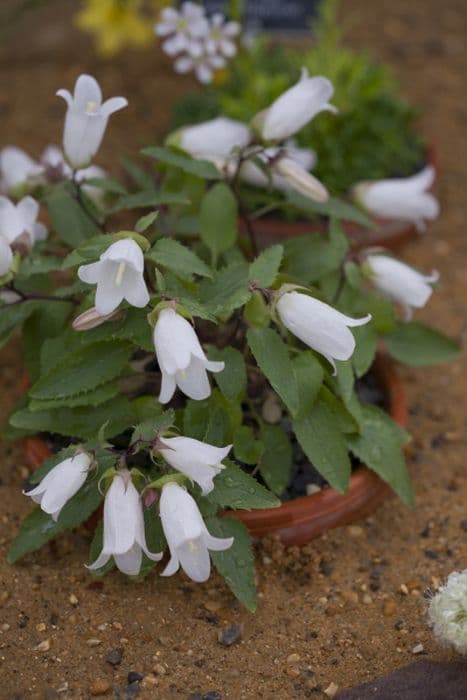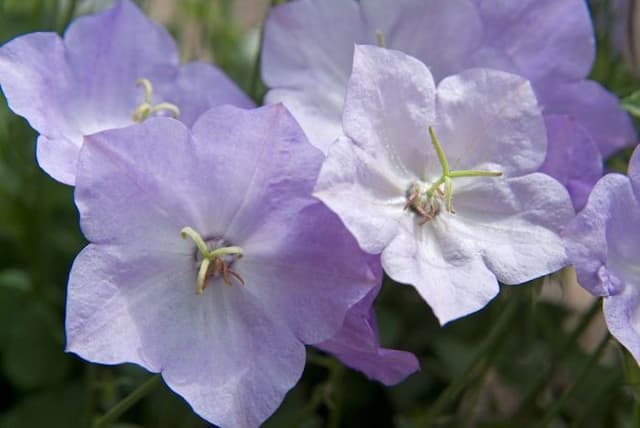Edging Lobelia Lobelia erinus 'Mrs Clibran'

ABOUT
Lobelia erinus 'Mrs Clibran', commonly known as edging lobelia or trailing lobelia, is a popular ornamental plant cherished for its delightful flowers and foliage. The plant displays an array of brilliant blue blossoms that feature a characteristic two-lipped shape. The upper lip has two lobes, while the lower lip comprises three, creating a delicate symmetry. Each flower is adorned with a white or light-colored eye, which contrasts distinctly against the vibrant blue petals, adding to its visual appeal. Foliage consists of small, narrow leaves that are typically green, although they may take on hints of bronze or darker shades, offering a lush backdrop for the profuse flowering. The leaves are often densely packed, creating a full and healthy appearance. This variety of lobelia has a mounding and trailing habit, which makes it a perfect choice for hanging baskets, containers, or as a ground cover, where it gracefully spills over edges, creating a soft, cascading effect. The overall appearance of Lobelia erinus 'Mrs Clibran' is one of lush, vivid color and delicate textures, which are harmoniously combined to create a spectacular display in gardens and outdoor spaces. It blooms generously under the right conditions, and while it is commonly seen during the warmer months of the year, its ornamental value throughout its blooming period is undeniable. Its stunning blue flowers are particularly attractive to garden enthusiasts and pollinators alike, including bees and butterflies.
About this plant
 Names
NamesFamily
Campanulaceae
Synonyms
Edging Lobelia, Garden Lobelia, Trailing Lobelia, Annual Lobelia
Common names
Lobelia erinus 'Mrs. Clibran'.
 Toxicity
ToxicityTo humans
The Lobelia, particularly the variety Lobelia erinus 'Mrs Clibran', contains several alkaloids that can be toxic to humans if ingested in significant amounts. Symptoms of Lobelia poisoning can include nausea, vomiting, diarrhea, cough, dizziness, excessive salivation, weakness, and difficulty breathing. In severe cases, it may lead to convulsions and coma. The toxic principles can affect the nervous system and can be particularly dangerous in high doses.
To pets
Lobelia is also toxic to pets, especially dogs and cats. Ingestion of Lobelia can lead to similar symptoms as in humans, including vomiting, diarrhea, excessive drooling, lethargy, and weakness. More serious cases can lead to difficulty in breathing, convulsions, and if left untreated, it could potentially be fatal. It is important to prevent pets from ingesting this plant and to seek veterinary care immediately if they do.
 Characteristics
CharacteristicsLife cycle
Annuals
Foliage type
Evergreen
Color of leaves
Green
Flower color
Blue
Height
0.5 feet (15 cm)
Spread
0.5 feet (15 cm)
Plant type
Herb
Hardiness zones
10
Native area
South Africa
Benefits
 General Benefits
General Benefits- Attracts pollinators: Lobelia erinus 'Mrs. Clibran' produces flowers that attract bees and butterflies, which can help pollinate other plants in your garden.
- Easy to grow: This variety of Lobelia is known for being easy to care for and can thrive in a range of conditions, making it suitable for novice gardeners.
- Colorful blooms: It offers vibrant blue flowers that can add a striking pop of color to garden beds, borders, or containers.
- Continuous flowering: With proper care, Lobelia 'Mrs. Clibran' can flower continuously from spring through fall, providing long-lasting color.
- Compact growth: Its compact growth habit makes it ideal for small spaces, hanging baskets, and as an edging plant in garden designs.
- Drought-tolerant: Once established, this plant is somewhat drought-tolerant, reducing the need for frequent watering.
- Versatile use: It can be used both as a bedding plant and in containers, allowing for diverse garden applications and design flexibility.
- Cooling effect: The lush foliage and dense flower coverage can provide a cooling effect in garden spaces during the hot summer months.
 Medical Properties
Medical PropertiesThis plant is not used for medical purposes.
 Air-purifying Qualities
Air-purifying QualitiesThis plant is not specifically known for air purifying qualities.
 Other Uses
Other Uses- Lobelia, specifically the Lobelia erinus 'Mrs. Clibran', can be used to create a natural dye, producing a range of hues depending on the mordant used in the dying process.
- The plant can be a food source for certain butterfly larvae, offering a way to support butterfly populations in a garden setting.
- Lobelia can be incorporated into educational projects or school gardens to teach children about plant growth cycles and the importance of insect pollinators.
- The blossoms of Lobelia can be used in pressed flower crafts, such as making bookmarks, greeting cards, or framed art due to their vibrant color.
- The dense growth habit of 'Mrs. Clibran' can be utilized in garden design as a living mulch, suppressing weeds and retaining soil moisture.
- In creative landscaping, Lobelia can be planted in the cracks of a stone wall or path to add unexpected bursts of color and life.
- The trailing varieties of Lobelia like 'Mrs. Clibran' can be used to edge a water garden without obstructing the view, as they can tolerate moist conditions.
- They can be used as indicators for over-watering in container gardens, as they will quickly wilt if they receive too much water, signaling gardeners to adjust their watering schedule.
- Lobelia flowers can serve as an ephemeral art material, useful for creating temporary garden installations that highlight the fleeting beauty of nature.
- As a companion plant, Lobelia can be positioned next to vegetable crops to attract beneficial insects that may assist in pollination or prey on harmful pests.
Interesting Facts
 Feng Shui
Feng ShuiThe Lobelia is not used in Feng Shui practice.
 Zodiac Sign Compitability
Zodiac Sign CompitabilityThe Lobelia is not used in astrology practice.
 Plant Symbolism
Plant Symbolism- Regret - The Lobelia plant is often associated with feelings of regret or bitterness, possibly arising from the acrid taste of its leaves which can lead to this symbolic connection.
- Malevolence - In some folklore, Lobelia is thought to have malevolent qualities, potentially due to its toxic nature when consumed in large quantities.
- Dislike or Distaste - Closely tied to its association with regret, Lobelia can symbolize a strong dislike or distaste, reflecting the negative reactions one might have to its bitterness.
 Water
WaterEdging lobelia requires consistent moisture, so it should be watered deeply and thoroughly when the top inch of soil feels dry to the touch. This often means watering approximately once a week, but frequency may increase during periods of high temperatures or dry conditions. A general guide could be to provide about 1 gallon of water per square foot of soil every week during the growing season, adjusting as necessary for rainfall or intense heat.
 Light
LightEdging lobelia thrives in full sun to partial shade conditions. The ideal spot would be where the plant can receive at least 3 to 5 hours of direct sunlight daily, while being protected from the harshest midday sun which can lead to scorching in exceedingly hot climates.
 Temperature
TemperatureEdging lobelia prefers cooler temperatures and will perform best in environments where daytime temperatures are between 60°F and 75°F. It can survive minimum temperatures down to about 30°F but does not tolerate frost well. The plant's ideal temperature range ensures vibrant growth and plentiful blooms.
 Pruning
PruningTo encourage bushiness and prolonged blooming, edging lobelia should be lightly pruned or pinched back after the initial flowering. Pruning can be done every few weeks during the growing season. The best time for major pruning is late winter or early spring before new growth begins.
 Cleaning
CleaningAs needed
 Soil
SoilThe best soil mix for Lobelia (Edging Lobelia) is light, fertile, and well-draining with added organic matter. A pH range between 5.5 and 6.5 is ideal.
 Repotting
RepottingEdging Lobelia typically does not require frequent repotting and can be repotted every 2-3 years or as needed when it outgrows its container.
 Humidity & Misting
Humidity & MistingEdging Lobelia thrives in average room humidity levels; however, it does appreciate higher humidity, especially during the growing season.
 Suitable locations
Suitable locationsIndoor
Keep Edging Lobelia in bright, indirect light and water moderately.
Outdoor
Place Edging Lobelia in partial shade and protect from intense midday sun.
Hardiness zone
10-11 USDA.
 Life cycle
Life cycleLobelia 'Mrs Clibran' begins its life as a seed, which, when sown in early spring and provided with the right conditions of light and temperature, germinates within a couple of weeks. Following germination, the seedlings develop into small plants, displaying their first true leaves, and are then ready to be transplanted. As vegetative growth continues, the plant forms a compact bush with numerous, small green leaves and begins to develop flower buds. The flowering stage, which can last throughout the summer into fall, is marked by vibrant blue or violet flowers that attract pollinators. After flowering, the plant sets seed, completing its reproductive cycle before it dies back with the onset of colder temperatures in the winter if it is treated as an annual, or it may persist if protected or grown in a favorable perennial climate. If the seeds are collected or fall to the ground, they can initiate a new cycle the following spring.
 Propogation
PropogationPropogation time
Spring-Early Summer
Lobelia, specifically Lobelia erinus 'Mrs. Clibran', is most commonly propagated through seed. The best time to sow Lobelia seeds is in late winter to early spring, around 10-12 weeks before the last frost date. To propagate, first, seeds are sprinkled onto the surface of a well-draining seed starting mix, as they need light to germinate. They are then lightly pressed into the soil but not covered. The container should be kept at a temperature of approximately 72 degrees Fahrenheit (22 degrees Celsius), and the soil should be consistently moist but not waterlogged. Germination typically occurs in 14-21 days. Once seedlings have developed a couple of sets of true leaves, they can be transplanted into individual pots or spaced out in the garden to grow to maturity.









